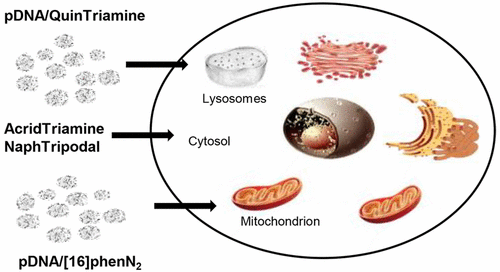当前位置:
X-MOL 学术
›
Biomacromolecules
›
论文详情
Our official English website, www.x-mol.net, welcomes your
feedback! (Note: you will need to create a separate account there.)
Targeting of Cellular Organelles by Fluorescent Plasmid DNA Nanoparticles
Biomacromolecules ( IF 5.5 ) Pub Date : 2017-08-25 00:00:00 , DOI: 10.1021/acs.biomac.7b00877 Diana Costa 1 , Carolina Costa 1 , Margarida Caldeira 2 , Luísa Cortes 2 , João A. Queiroz 1 , Carla Cruz 1
Biomacromolecules ( IF 5.5 ) Pub Date : 2017-08-25 00:00:00 , DOI: 10.1021/acs.biomac.7b00877 Diana Costa 1 , Carolina Costa 1 , Margarida Caldeira 2 , Luísa Cortes 2 , João A. Queiroz 1 , Carla Cruz 1
Affiliation

|
The development of a suitable delivery system and the targeting of intracellular organelles are both essential for the success of drug and gene therapies. The conception of fluorescent ligands, displaying targeting specificity together with low toxicity, is an emerging and reliable tool to develop innovative delivery systems. Biocompatible BSA or pDNA/ligand nanoparticles were synthesized by a coprecipitation method and were shown to display adequate sizes and morphology for delivery purposes, and positive surface charges. Additionally, these fluorescent vectors can target specific intracellular organelles. In vitro transfection mediated by BSA or pDNA based carriers can result in the accumulation of BSA in the cytosol, lysosomes, and mitochondria or the expression of the plasmid-encoded protein, respectively. Moreover, the therapeutic effect of pDNA/ligand vectors in cancer gene therapy instigates further research aiming clinical translation.
中文翻译:

荧光质粒DNA纳米粒子对细胞器的靶向。
合适的递送系统的开发和细胞内细胞器的靶向对于药物和基因疗法的成功都是必不可少的。荧光配体的概念具有靶向特异性和低毒性,是开发新型传递系统的新兴且可靠的工具。通过共沉淀法合成了生物相容性BSA或pDNA /配体纳米粒子,并显示出足够的大小和形态用于传递,并具有正表面电荷。另外,这些荧光载体可以靶向特定的细胞内细胞器。由BSA或基于pDNA的载体介导的体外转染可以分别导致BSA在细胞质,溶酶体和线粒体中的积累或质粒编码蛋白的表达。而且,
更新日期:2017-08-26
中文翻译:

荧光质粒DNA纳米粒子对细胞器的靶向。
合适的递送系统的开发和细胞内细胞器的靶向对于药物和基因疗法的成功都是必不可少的。荧光配体的概念具有靶向特异性和低毒性,是开发新型传递系统的新兴且可靠的工具。通过共沉淀法合成了生物相容性BSA或pDNA /配体纳米粒子,并显示出足够的大小和形态用于传递,并具有正表面电荷。另外,这些荧光载体可以靶向特定的细胞内细胞器。由BSA或基于pDNA的载体介导的体外转染可以分别导致BSA在细胞质,溶酶体和线粒体中的积累或质粒编码蛋白的表达。而且,










































 京公网安备 11010802027423号
京公网安备 11010802027423号